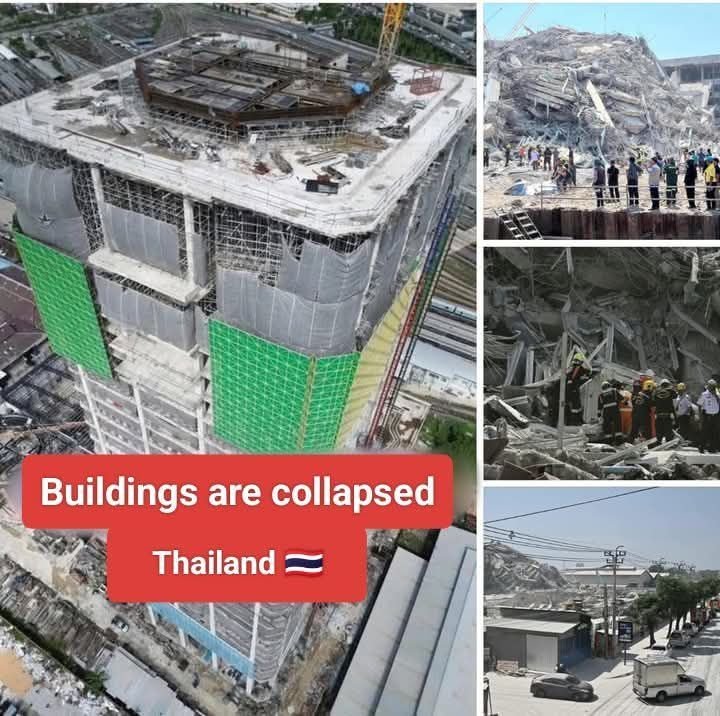A powerful earthquake has hit Myanmar and neighbouring Thailand, destroying buildings, damaging infrastructure and killing more than 150 people.
The head of Myanmar’s military government, Senior General Min Aung Hlaing, said that at least 144 people were killed and 730 others were injured in his country. The quake also hit Thailand, where at least 10 people were killed in the capital, Bangkok, according to city authorities.
A magnitude 7.7 quake struck just outside Myanmar’s ancient capital Mandalay at 12.50pm (06:20 GMT). The initial tremor was followed minutes later by a magnitude 6.4 aftershock, according to the United States Geological Survey (USGS).
Photos from Myanmar’s current capital, Naypyidaw, showed multiple buildings used to house civil servants destroyed by the quake and rescue crews pulling victims from the rubble.
General Min Aung Hlaing, the head of Myanmar’s military government said the death toll was expected to rise and invited “any country” to provide help and donations.
“I’ve been in earthquakes in this region before, and I’ve never felt anything as strong as that,” said Al Jazeera’s Tony Cheng, who was outside Myanmar’s Defence Services Museum in Naypyidaw when the earthquake hit.
Cheng and others sought shelter under a doorway as large roofing and side panels crashed down. The tremors began gently but quickly intensified, causing concrete panels to break off the building, he said.
In the Thai capital, a 33-storey building that was under construction near Chatuchak Market crumpled into a cloud of dust with onlookers seen screaming and running in a video posted on social media.
At least eight people were killed in the building collapse, Interior Minister Anutin Charnvirakul was quoted as saying by news agency AFP. He said that 90 to 110 people remained unaccounted for.
Al Jazeera’s Imran Khan, who was in Bangkok when the quake hit, said: “People are out on the streets here. None of the trains are moving. … Traffic is absolutely gridlocked. The buildings have been shuttered in the centre of the city.”
State of emergency
Myanmar’s military government declared a state of emergency in six regions and states, including Naypyidaw and Mandalay.
Major General Zaw Min Tun, a government spokesperson, told MRTV that blood was in high demand in the hospitals in earthquake-hit areas, especially Mandalay, Sagaing and Naypyidaw.
In Mandalay, Myanmar’s second largest city, located in the country’s Buddhist heartland, the earthquake reportedly brought down multiple buildings, including the Ma Soe Yane Monastery, one of the largest in the city, and damaged the former royal palace.
A video posted online showed robed monks in the street shooting video of the multistorey monastery before it suddenly collapsed. It was not immediately clear whether anyone was harmed.
In the Sagaing region just west of the city, a 90-year-old bridge collapsed, and some sections of the highway connecting Mandalay and Myanmar’s largest city, Yangon, were also damaged.
The Red Cross said downed power lines added to challenges for their teams trying to reach several hard-hit areas.
At least three people were killed in the town of Taungoo, south of Naypyidaw, when a mosque partially collapsed, according to witnesses who spoke to news agency Reuters.
“We were saying prayers when the shaking started. … Three died on the spot,” one of the witnesses said.
Local media reported at least two people died and 20 were injured when a hotel collapsed in Aung Ban.
A major hospital in Naypyidaw was declared a “mass casualty area”, an official at the facility told the AFP news agency.
Rows of wounded were treated outside the emergency department of the 1,000-bed general hospital, some writhing in pain, others lying still as relatives sought to comfort them.
Thai Prime Minister Paetongtarn Shinawatra announced a state of emergency in her country. Meanwhile, Bangkok has been declared a disaster area, the capital’s city hall said on Friday.
Urban rail systems in Bangkok were temporarily closed but were expected to resume services on Saturday.
Tremors were also felt in the Yunnan and Sichuan provinces in China. They caused injuries and damage to houses in the city of Ruili on the border with northern Myanmar, according to Chinese media reports.
Videos that one outlet said it had received from a person in Ruili in Yunnan showed building debris littering a street and a person being wheeled on a stretcher towards an ambulance.
Cambodia, Bangladesh and India also reported tremors.
Humanitarian response
Julie Mehigan, head of Asia, the Middle East and Europe for Christian Aid, said the earthquake would have left many people “devastated” in war-torn Myanmar, which is already experiencing a significant humanitarian crisis.
“Myanmar is one of the least developed countries in the world. Even before this heartbreaking earthquake, we know conflict and displacement has left countless people in real need,” she said.
World Health Organization spokeswoman Margaret Harris said at a media briefing that the earthquake was a “very, very big threat to life and health”.
“We’ve activated our logistics hub to look particularly for trauma supplies and things like external fixators because we expect that there will be many, many injuries that need to be dealt with,” she said.
Marie Manrique, programme coordinator for the International Federation of the Red Cross, told reporters in Geneva via videolink from Yangon that the organisation anticipates the impact to be “quite large”.
“Public infrastructure has been damaged, including roads, bridges and public buildings. We currently have concerns for large-scale dams that people are watching to see the conditions of them,” she said.
Previous quakes in Myanmar
Earthquakes are relatively common in Myanmar, where six strong quakes of magnitude 7 or higher struck from 1930 to 1956 near the Sagaing Fault, which runs north to south through the centre of the country, according to the USGS.
A magnitude 6.8 earthquake in the ancient capital Bagan in central Myanmar killed three people in 2016, toppling spires and crumbling temple walls at the tourist destination.
The impoverished Southeast Asian nation has a strained medical system, especially in its rural states.
Moreover, Cheng said it is important to remember that Myanmar is a country in the grips of a bitter civil war.
“A lot of the people have moved from the countryside into the cities to try and escape,” he noted. “That has meant it is densely overcrowded and the building standards are not particularly strong.”


